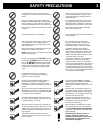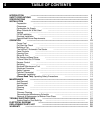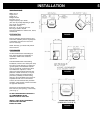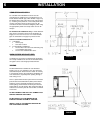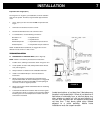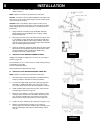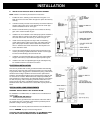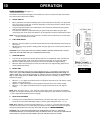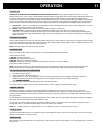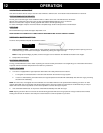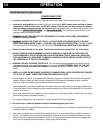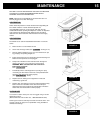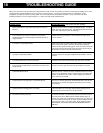
PROPER FUEL
THIS STOVE IS APPROVED FOR BURNING PELLETIZED WOOD FUEL ONLY! Factory-approved pellets are those ¼” or 5/16” in
diameter and not over 1” long. Longer or thicker pellets sometimes bridge the auger flights, which prevents proper pellet feed. Burning wood
in forms other than pellets is not permitted. It will violate the building codes for which the stove has been approved and will void all
warranties. The design incorporates automatic feed of the pellet fuel into the fire at a carefully prescribed rate. Any additional fuel introduced
by hand will not increase heat output but may seriously impair the stoves performance by generating considerable smoke. Do not burn wet
pellets. The stove’s performance depends heavily on the quality of your pellet fuel. Avoid pellet brands that display these characteristics:
a. Excess Fines – “Fines” is a term describing crushed pellets or loose material that looks like sawdust or sand. Pellets can be screened
before being placed in hopper to remove most fines.
b. Binders – Some pellets are produced with materials to hold the together, or “bind” them.
c. High ash content – Poor quality pellets will often create smoke and dirty glass. They will create a need for more frequent
maintenance. You will have to empty the burnpot plus vacuum the entire system more often. Poor quality pellets could damage the
auger. Breckwell cannot accept responsibility for damage due to poor quality pellets. Your dealer can recommend a good quality pellet
dealer in your area.
PRE-START-UP CHECK
Remove optional imitation log set if in use. Remove burnpot, making sure it is clean and none of the air holes are plugged. Clean the firebox,
and then reinstall burnpot. Clean door glass if necessary (a dry cloth or paper towel is usually sufficient). Never use abrasive cleaners on the
glass or door. Check fuel in the hopper, and refill if necessary.
NOTE: The P2700 Hopper can hold up to 50 lbs. of pellets.
BUILDING A FIRE
Never use a grate or other means of supporting the fuel. Use only the Breckwell approved burnpot.
During the start up period:
1) DO NOT open the viewing door.
2) DO NOT open the damper more than ¾”.
3) DO NOT add pellets to the burnpot by hand.
4) DO NOT use the Fuel Feed button (unless you are priming the auger after running out of pellets).
A dangerous condition could result.
NOTE: During the first few fires, your stove will emit an odor as the high temperature paint cures or becomes seasoned to the metal.
Maintaining smaller fires will minimize this. Avoid placing items on stovetop during this period because paint could be affected.
THE HOTROD AUTOMATIC FIRESTARTER
a. Fill hopper and clean burnpot.
b. Press “On/Off” button. Make sure light is on.
c. Adjust damper to ½” to ¾” open (pushed in is closed). This will vary depending on your installation and elevation. Once fire is
established adjust for desired flame increasing the amount the damper is open as the heat setting is increased.
(See “DAMPER CONTROL”)
d. Adjust feed rate to desired setting by pressing “Heat Level Advance” button.
If fire doesn’t start in 15 minutes, press “On/Off”, wait a few minutes, clear the burnpot, and start procedure again.
DAMPER CONTROL
The damper control rod on the stove’s lower left side adjusts the combustion air. This control is necessary due to the varied burn
characteristics of individual installations, different pellet brands and pellet feed rates. It allows you to improve the efficiency of your stove.
Providing correct combustion air will reduce the frequency of cleaning your glass door and prevent the rapid buildup of creosote inside your
stove and chimney.
You should adjust the damper based on the fire’s appearance. A low, reddish, dirty fire can be improved by pulling the damper out slightly. A
“blow torch” fire can be improved by pushing the damper in a bit.
As a general rule, on lower feed rate settings, the damper should be in farther. On higher feed rates, the damper should be more open.
Through trial and error, you will find the best setting. Consult your dealer if you need help.
NOTE: On “1”, damper should be out approximately ½” to ¾”. If damper is out too far, it can cause the fire to go out.
OPENING DOOR
If the door is opened while the stove is in operation it must be closed within 30 seconds or the stove will shut down. If the stove shuts down
push the “On/Off” button to re-start your stove.
ROOM AIR FAN
When starting your stove the Room Air Fan will not come on until the stove’s heat exchanger warms up. This usually takes about 10 minutes
from start-up.
OPERATION
11



